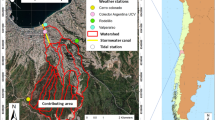Abstract
The concept of collecting surface runoff on the slopes in canals cut across the western slopes of the Western Ghats, in order to divert part of a flow in the west flowing rivers to the east by gravity, is being promoted in Karnataka. This paper presents a study of the hydrological feasibility of such canals, termed ‘garland canals’ and claimed to be an environmental friendly alternative to the conventional technologies for inter-basin transfer of water, by their promoters. The paper presents a methodology for disaggregating normal annual rainfall into 15-min magnitudes and its application for simulating surface runoff, using a knowledge of infiltration rates on the slopes. The study has been carried out considering a part of a garland canal proposed for diverting the river Netravathi in the state. The results from the study reveal that significant amounts of flow can be collected in the proposed canal only if streams are also tapped and that because of the arrangements necessary for the purpose, garland canals cannot be considered a means superior to the conventional methods for diverting west flowing rivers.











Similar content being viewed by others
References
Badarinath B, Muralidhar S, Waddatti S H, and Kulakarni V S 2010 A study on diversion of water in Netravathi basin by garland canals; Unpubl. BE dissertation submitted to NIE, Mysore.
Chow V T, Maidment D R and Mays L W 1988 Applied Hydrology; McGraw-Hill Book Co., New York.
De Lima M I P and Grasman J 1999 Multifractal analysis of 15-min and daily rainfall from a semi-arid region in Portugal; J. Hydrol. 220 1–11.
Gyasi-Agyei Y 1999 Identification of regional parameters of a stochastic model for rainfall disaggregation; J. Hydrol. 223 148–163.
Hershenhorn J and Woolhiser D A 1987 Disaggregation of daily rainfall; J. Hydrol. 95 299–322.
Hewlett J D and Nutter L W 1970 The varying source area of stream flow from upland basins; Proc. Symp. Watershed Management August 70, Montana State Univ., Bozeman, Montana Publ., ASCE NY, 10017 65–83.
Jones J A 1979 Extending the Hewlette model of stream runoff generation area; Inst. of British Geographers 112 110–114.
Merten J, Raes D and Feyen J 2002 Incorporating rainfall intensity into daily rainfall records for simulating runoff and infiltration into soil profiles; Hydrol. Process. 16 731–739.
Paramasivaiya G S 2000 ‘Project at a glance’ – report on gravity diversion of Netravathi submitted to Govt. of Karnataka on 25/08/2000.
Prasad R and Malhotra K 1987 Some aspects of water resources in Karnataka; Published by Dept. of Civil Engg., Indian Institute of Science, Bengaluru.
Putty M R Y 2010 Principles of Hydrology; IK International Publ., New Delhi.
Putty M R Y and Prasad R 2000 Runoff processes in head water catchments – an experimental study in Western Ghats, south India; J. Hydrol. 235 63–71.
Putty M R Y, Prasad V S R K and Ramaswamy R 2000 A study on the rainfall intensity pattern in Western Ghats, Karnataka; Proc. Workshop on Watershed level in Western Ghats, CWRDM, Kozhikode, Kerala, February 2000, pp. 44–51.
Putty M R Y, Swamy B K K and Prasad R 1997 A study on infiltration rates in a very wet zone of the Western Ghats; Hydrol. J. IAH 20(1–4) 1–17.
Srinivasa P, Anil Kumar H V, Santhosh R and Avinash A 2011 Infiltration rate studies at the Kumaradhara Basin of Western Ghats; BE project report submitted to the Department of Civil Engineering, The National Institute of Engineering, Mysore.
Ward R C 1984 On the response of headwater streams in humid areas; J. Hydrol. 74 171–189.
Ward R C and Robinson M 2011 Principles of Hydrology, 4th edn; Tata McGrawHill, New Delhi.
Tipperudrappa N M 2009 Studies on rainfall intensity pattern in Karnataka with particular reference to the Western Ghats; Unpubl. Ph.D. thesis submitted to Visvesvaraya Technological University, Belgaum, Karnataka, India.
Acknowledgements
This study is a part of the research project ‘Impact of LULC Changes on Stream flow Regime – A case study of Netravathi Catchment, Karnataka’, sponsored by ISRO, under its RESPOND Programme. The authors acknowledge with gratitude the financial assistance provided for the project by ISRO. The authors also acknowledge the students of The National Institute of Engg., Mysore, who are involved in the studies concerning the project.
Author information
Authors and Affiliations
Corresponding author
Rights and permissions
About this article
Cite this article
Yadupathi Putty, M.R., Thipperudrappa, N.M. & Chandramouli, P.N. Hydrological feasibility of gravity diversion of the west flowing Nethravathi in Karnataka. J Earth Syst Sci 123, 1781–1792 (2014). https://doi.org/10.1007/s12040-014-0511-3
Received:
Revised:
Accepted:
Published:
Issue Date:
DOI: https://doi.org/10.1007/s12040-014-0511-3




